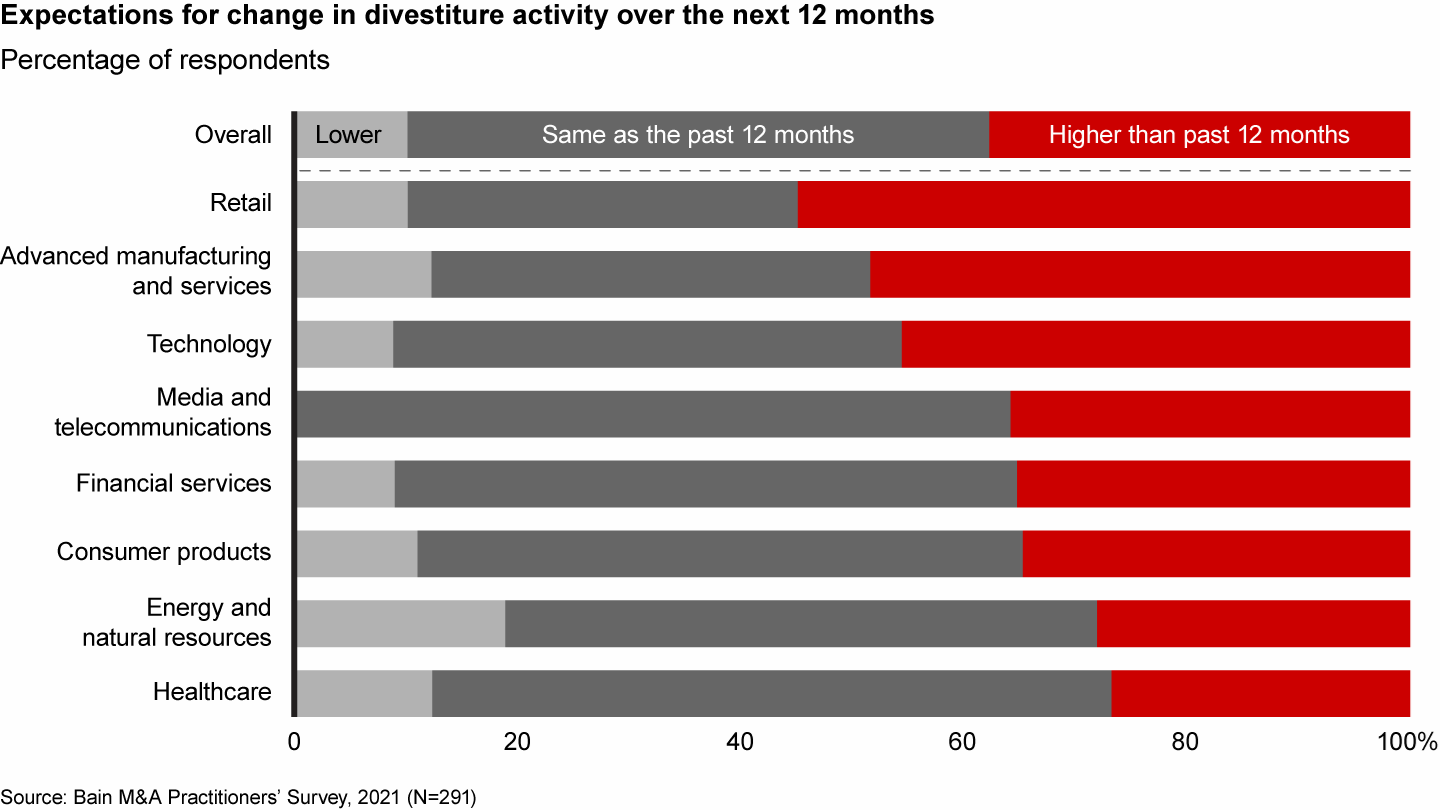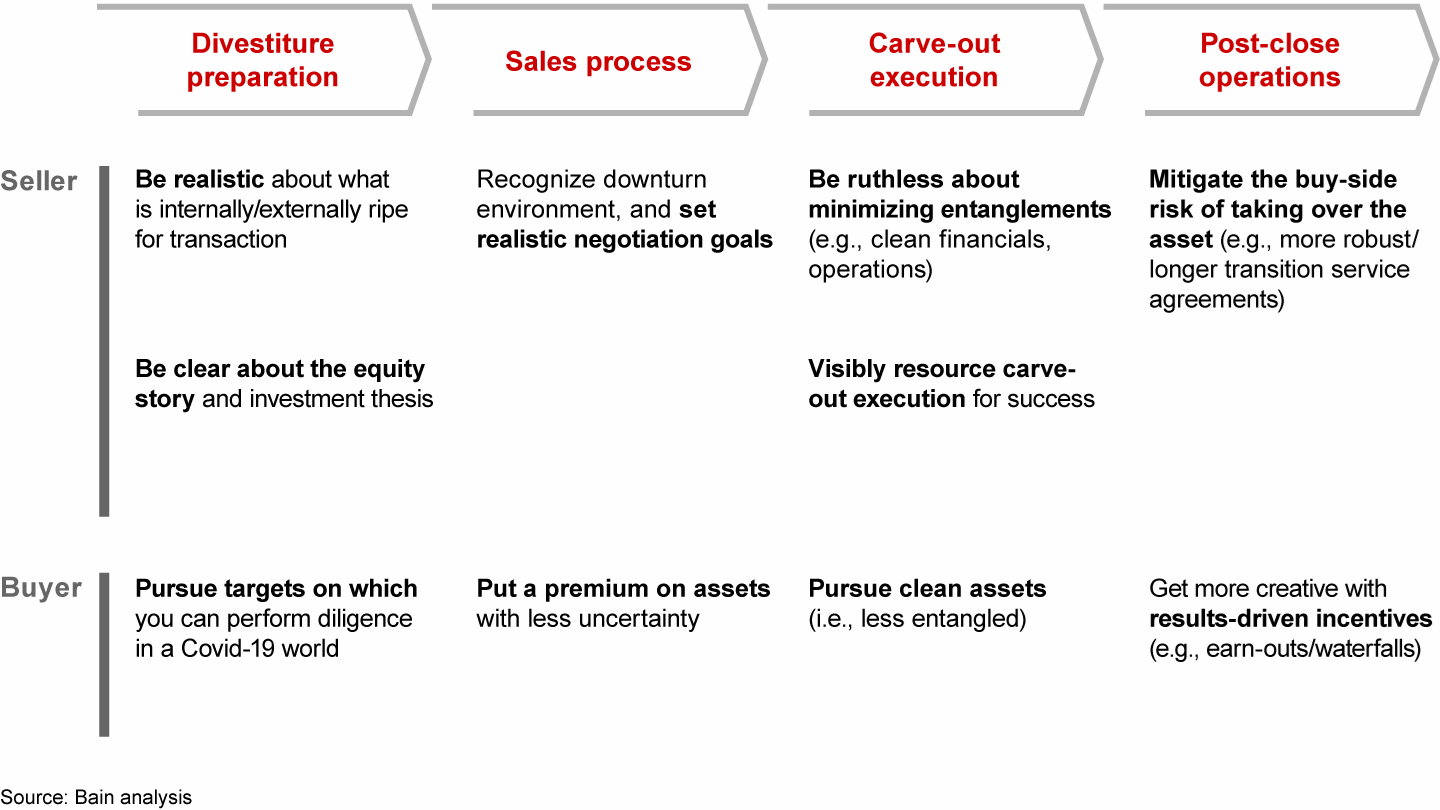M&A Report

Executive Summary
- Divestiture volume declined by 15% and value dropped by 21% in 2020. But that will change.
- Many companies need to divest noncore businesses to refocus on strategic priorities, raise liquidity, or fuel growth out of the downturn. Roughly 40% of M&A practitioners surveyed expect divestitures to rise in 2021.
- Carve-outs are not straightforward; they are particularly challenging during this crisis. For example, in addition to agreeing on valuations amid economic uncertainty, there’s the difficulty of negotiating virtual diligence.
- We see strong buy-side demand from corporates and private equity. Also, the market will reward sellers and buyers that creatively bridge the gap between them by taking flexible approaches.
There’s greater urgency to divest noncore assets, and it’s harder than ever
Covid-19 has placed unprecedented demands on management bandwidth, resulting in divestiture activity being put on the back burner. Divestiture volume was down 15% in 2020, and value dropped by 21%. The easy excuses are economic uncertainty and the demands of conducting a virtual sales process. This is a missed opportunity as superior returns arise from taking action when others are timid.
The crisis has added an urgency to divest as companies need to divert their scarce resources to the best opportunities amid increasing industry disruption.
Depending on how the pandemic unfolds, we anticipate a possible sharp increase in corporate divestiture activity to make a comeback in 2021 and beyond. Roughly 40% of the nearly 300 M&A practitioners we surveyed expect a rise in divestitures over the next 12 months; only 10% of respondents felt that it would be lower (see Figure 1). Some of the increase in divestitures will be a resumption of decisions made prior to the pandemic, especially situations in which businesses have been disrupted by new technologies or no longer factor into long-term growth plans. Additionally, the pandemic itself has raised liquidity concerns for many companies that took on debt to survive the downturn. Selling assets will help many companies pay down their debt burden. Finally, some businesses that may have been marginally attractive in pre-pandemic portfolios will not earn their keep as new consumer behaviors continue post the great lockdown. The industries that were hardest hit during the pandemic, such as retail, energy, and hospitality, will likely see the highest level of divestiture activity.
40% of survey respondents expect divesture activity to increase over the next 12 months


Our research shows that winners from past downturns used the opportunity to outinvest competitors, with M&A and divestitures playing a prominent role. In May 2020, Sanofi divested $5 billion worth of its minority equity stake in Regeneron, with the expectation to use the proceeds to speed its strategic repositioning toward specialty pharma. Three months later, Sanofi announced a $3.7 billion acquisition of US-based biotech company Principia BioPharma.
While divestitures are more important than ever, they also are harder than ever. Management has never been more distracted. Covid-19 has made diligence remote and more digital, and it is increasingly challenging for buyer and seller to agree on valuations in heavily disrupted industries facing unpredictable futures. This comes on top of common divestiture issues such as the difficulty in negotiating asset perimeters, entanglements, and the critical transition service agreements (TSAs) required to make deals happen.
Fortunately, there is willing buy-side demand for divested assets. About 80% of surveyed M&A practitioners expect to revisit their short- and long-term strategies over the next 12 months, and 62% expect more interest in acquiring carved-out assets in their industries than they experienced over the previous 12 months. Meanwhile, private equity (PE) interest in carved-out assets is expected to remain high in the year ahead, with limited partners under pressure to continue to put dry powder to use. Across industries, 30% of respondents anticipate PE to increase its interest in buying divested assets, with the biggest anticipated rise in advanced manufacturing.
Flexibility can bridge the gap between seller and buyer
Companies that move quickly and creatively to overcome the obstacles to divesting will outpace competitors out of the downturn. There are proven approaches to bridging the gap between seller and buyer (see Figure 2).
How to bridge the gap between the need to divest and the added challenges


For example, with many industries facing uncertain futures, it is critical to develop clear equity stories and investment theses that address multiple possible scenarios. Divesting companies also need to be ruthless about minimizing entanglements, with deal perimeters that lead to clean financials and clean operations, and they visibly need to resource the separation program for success. They need to acknowledge that the more complex divestiture processes will require more resources and more time than usual. In the downturn environment, sellers also must set realistic negotiation goals and mitigate the risk for buyers by offering longer-term or more robust TSAs.
As they hunt for deals in this uncertain economic environment, buyers can minimize their risk by going after clean assets in which they can perform diligence from a distance and in which there is less entanglement. They can focus their efforts on assets with greater certainty, acknowledging the premium for such assets. They can structure deals to share the risk and upside potential with the seller. That means getting more creative with earn-outs, waterfalls, use of equity, and other results-driven incentives.
In our survey, 45% of respondents expect to see more earn-out deals as a way to hedge risk in divestitures.
Bouygues Telecom struck such a deal in June, when it agreed to purchase Euro-Information Telecom, a subsidiary of Crédit Mutuel group’s Euro-Information. The acquisition price included a fixed part of €530 million to be paid on the closing of the deal and an additional part of between €140 million and €325 million contingent on the achievement of certain business performance criteria and payable over several years. In another instance, when ArcelorMittal USA was sold to Cleveland-Cliffs in September 2020, the buyer agreed to pay $1.4 billion (one-third of that in cash and two-thirds in the form of equity) to share the upside and downside risks.
In the Covid-19 world and beyond, these creative deal structures will become increasingly necessary to align the incentives of buyers with sellers and to hedge the risk, making divestitures a win-win.

How M&A and Divestitures Helped Asia’s Conglomerates
Conglomerates in China, Japan, and Korea faced a conundrum. The diversified business model that served them so well for decades turned into a disadvantage.